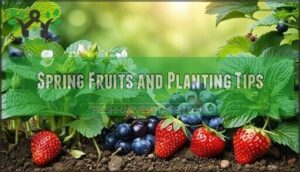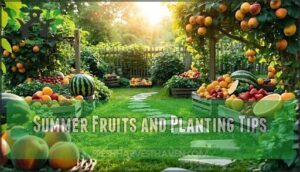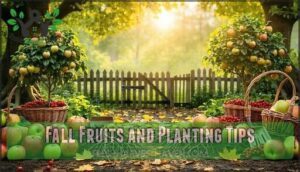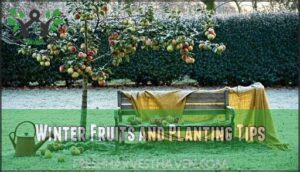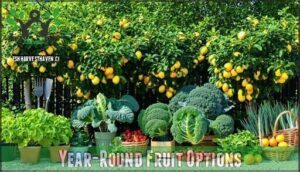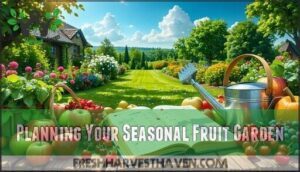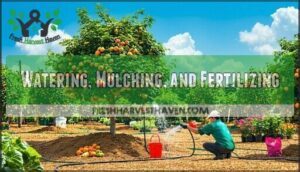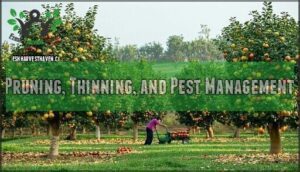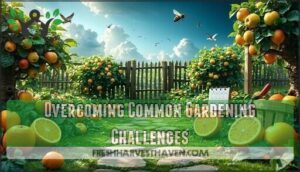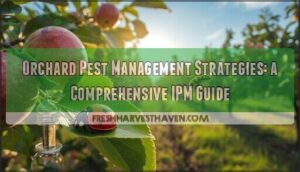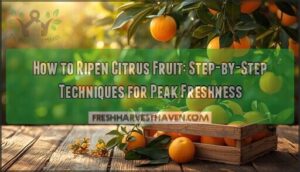This site is supported by our readers. We may earn a commission, at no cost to you, if you purchase through links.
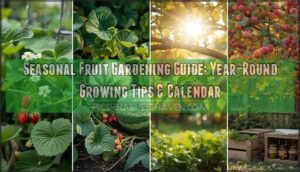
You’ll cut grocery bills while enjoying peak-vitamin produce year-round. Success depends on proper timing, watering schedules, and strategic pruning. Weather extremes and pests will test you, but integrated management approaches keep your garden thriving.
The secret isn’t just knowing what to plant—it’s mastering when and how to work with each season’s unique challenges and opportunities.
Table Of Contents
- Key Takeaways
- What is Seasonal Fruit Gardening?
- Choosing Fruits for Each Season
- Planning Your Seasonal Fruit Garden
- Essential Fruit Gardening Techniques
- Overcoming Common Gardening Challenges
- Frequently Asked Questions (FAQs)
- What is a seasonal planting guide?
- Is it better to eat fruit & vegetables in season?
- How do I prepare my fruit garden for the fall?
- How can a seasonal planting schedule help a beginner?
- Are fruits & vegetables at their best?
- What fruit grows all year round?
- What fruits are in four seasons?
- When to start a fruit garden?
- What fruit is good at this time of year?
- Conclusion
Key Takeaways
- You’ll maximize your harvest by timing plantings around frost dates—plant strawberries in early spring after the soil warms, but wait until after the last frost for tender varieties like melons and citrus.
- You can slash grocery bills by $600 annually while getting 30-40% more vitamins from homegrown fruit that’s harvested at peak ripeness compared to store-bought produce.
- You’ll succeed by mastering seasonal care techniques: consistent watering with drip irrigation, strategic winter pruning during dormancy, and proactive pest monitoring with organic sprays and garden sanitation.
- You should start small with cold-hardy varieties like apples and berries, then gradually expand as you learn each season’s rhythm—spring planting, summer maintenance, fall harvesting, and winter planning.
What is Seasonal Fruit Gardening?
Seasonal fruit gardening means you’ll plant, grow, and harvest different fruits based on your local climate’s natural cycles throughout the year. You’ll work with nature’s timing—planting strawberries in early spring when soil warms, pruning apple trees during winter dormancy, and protecting peach blossoms from late frosts that can wipe out entire harvests.
Seasonal Definition and Meaning
Seasonal patterns in gardening follow nature’s rhythm, where Agricultural Cycles dictate when you’ll plant, tend, and harvest your fruits. The seasonal definition simply means activities that occur during specific times of year due to Climate Effects and Environmental Impact.
Think of it as your garden’s natural calendar—spring awakens growth, summer nurtures development, fall delivers harvests, and winter brings rest. Understanding these Economic Fluctuations helps you increase yields while working with, not against, seasonal meaning.
How Seasons Affect Fruit Gardening
Each seasonal shift brings unique challenges that’ll either make or break your fruit harvest. Your garden dances to nature’s rhythm, responding to these key seasonal patterns:
Your success in drought gardening starts with proper soil preparation and smart plant selection before the heat hits. You’ll want to amend heavy clay soils with compost and choose native varieties that naturally handle your area’s dry spells
- Spring awakens dormant buds as soil temperature rises above 40°F
- Summer heat accelerates fruit ripening and demands consistent watering
- Fall’s climate shift triggers harvest cycles for apples and pears
- Winter’s chill provides essential dormancy hours most fruit trees need
Understanding these natural cycles helps you work with the seasons instead of fighting them.
Benefits of Seasonal Gardening
Growing your own seasonal bounty transforms your relationship with fresh produce while supporting sustainable living. You’ll slash grocery bills, reduce your carbon footprint, and enjoy eco-friendly gardening that connects you to natural cycles.
| Benefit | Spring/Summer | Fall/Winter |
|---|---|---|
| Cost Savings | Fresh berries at $2/lb vs $6 store price | Stored apples last 6+ months |
| Health Impact | Peak vitamin content at harvesting | Natural preservation retains nutrients |
| Environmental | Zero food miles from garden to table | Composting creates soil fertility loop |
Choosing Fruits for Each Season
You’ll optimize your garden’s productivity by selecting fruits that match each season’s unique growing conditions and harvest windows. Strategic timing means planting spring strawberries in March, summer blueberries by late April, and fall apples according to your local frost dates to guarantee proper fruit development before winter arrives.
Spring Fruits and Planting Tips
Spring kicks off your gardening year with perfect planting weather and fresh opportunities. Your fruit selection should focus on cold-hardy varieties that thrive in cooler temperatures. Proper soil preparation and garden layout set the foundation for healthy growth throughout the season.
- Strawberries – Plant bare-root varieties 4-6 weeks before the last frost for June berries
- Rhubarb crowns – Establish early for years of tart stalks; needs well-draining soil
- Berry bushes – Blueberries and blackberries love acidic soil with morning sun exposure
- Fruit trees – Apples, pears, and stone fruits benefit from dormant season planting
- Asparagus crowns – Though technically a vegetable, these perennial spears reward patient gardeners
Summer Fruits and Planting Tips
Summer brings peak harvesting opportunities for warmth-loving fruits. Berries, melons, and stone fruits thrive in summer heat. Your garden layout should prioritize sun exposure as soil temperature rises. Plant heat-tolerant varieties early, ensuring water conservation through mulching and drip irrigation for an ideal summer harvest.
| Fruit Type | Planting Time | Ripening Period |
|---|---|---|
| Strawberries | Late spring | June-August |
| Melons | Early summer | August-September |
| Peaches | Spring planting | July-August |
Fall Fruits and Planting Tips
Fall brings your garden’s grand finale with late-season treasures ready for harvesting. This season’s cooler weather creates perfect conditions for planting certain fruits while preparing existing plants for winter.
Here are five key fall gardening tasks:
- Plant bare-root fruit trees – October through November offers ideal conditions for root establishment
- Harvest late apples, pears, and cranberries – Peak ripeness arrives with cooler temperatures
- Begin Autumn Pruning – Remove dead branches and shape dormant plants
- Prepare Fruit Storage areas – Clean root cellars and storage containers for winter preservation
- Start Garden Cleanup – Clear fallen fruit to prevent pest overwintering
Focus on cold-hardy varieties that thrive in dropping temperatures. Late-season apples like Granny Smith and Fuji reach maturity now. Your fall efforts set the stage for next year’s bounty while maximizing this season’s harvest.
Winter Fruits and Planting Tips
Winter doesn’t mean your fruit garden shuts down completely. You’ll want to focus on Winter Harvesting of stored apples and pears from fall plantings.
Cold Climate varieties like hardy kiwis thrive with proper Frost Protection using row covers.
This season’s perfect for Seasonal Pruning of dormant trees and planning Fruit Preservation methods for next year’s bounty.
Year-Round Fruit Options
Everbearing varieties break seasonal constraints, delivering continuous harvests throughout your growing season. Meyer lemons and alpine strawberries provide year-round fruit storage opportunities, while indoor options like dwarf citrus trees guarantee seasonal harvest diversity.
Strategic crop rotation with perennial kale and artichokes maximizes garden diversity. Combine these with pomegranates for thorough fruit preservation and truly liberated gardening experiences.
By incorporating year round harvest techniques, gardeners can enjoy a constant supply of fresh produce.
Planning Your Seasonal Fruit Garden
You’ll need precise timing that aligns your planting schedule with local frost dates to enhance fruit maturation before cold weather hits.
Understanding chill hours and heat requirements for varieties like apples and cherries ensures proper flowering, while creating a detailed gardening calendar keeps your seasonal efforts organized and productive.
Timing Plantings by Frost Dates
Nothing beats knowing your last frost date when planning your seasonal fruit garden. This essential weather forecasting benchmark determines when it’s safe to plant tender varieties and schedule your gardening calendars around climate zones.
- Check your local frost date using USDA hardiness maps and regional weather data
- Plant cold-hardy fruits like apples two weeks before spring frost dates
- Schedule tender varieties like citrus after all danger of frost passes
- Plan fall planting windows 6-8 weeks before first expected frost
Understanding Chill Hours and Heat Needs
Your fruit trees need specific Temperature Management to thrive through Fruit Dormancy periods. Chill Hour Calculation determines when stone fruits break dormancy, while Heat Accumulation triggers flowering. Understanding these Climate Adaptation requirements helps you select varieties suited for your growing zone and refine Harvesting timing.
| Fruit Type | Chill Hours Needed |
|---|---|
| Apples | 400-1,000 hours |
| Cherries | 400-1,200 hours |
| Peaches | 150-1,000 hours |
| Plums | 400-1,000 hours |
| Pears | 400-1,500 hours |
Creating a Gardening Calendar
Building your gardening calendar transforms seasonal planning from chaos into clockwork precision. Mark spring planting dates after your last frost, noting when apples and cherries need their chill hours satisfied.
Schedule summer fruit maturation windows and fall planting opportunities. Include crop rotation notes and harvest timelines.
**Your tailored gardening schedules become your roadmap to year-round success.
Essential Fruit Gardening Techniques
You’ll master the core techniques that transform your fruit garden from surviving to thriving throughout each season.
These fundamental methods—proper watering schedules, strategic pruning timing, and effective pest monitoring—directly impact whether your apple trees produce abundant harvests or your strawberry patch struggles against common diseases.
Watering, Mulching, and Fertilizing
Your garden’s success hinges on smart watering, mulching, and fertilizing practices. Monitor soil moisture regularly—fruit trees need consistent hydration without waterlogged conditions. Use drip irrigation systems to deliver targeted water while conserving resources.
Apply organic mulch types like wood chips around plants for water conservation and nutrient cycling.
Time fertilizer applications with seasonal growth phases. These soil preparation techniques and plant care instructions form your foundation for thriving fruit production.
Pruning, Thinning, and Pest Management
Sharp pruning tools make clean cuts that heal faster and resist disease. Prune fruit trees during dormancy in late winter to boost sunlight penetration.
Thin excess fruits in spring so remaining ones grow larger and sweeter.
Regular crop monitoring helps you spot pest issues early. Practice garden sanitation by removing fallen fruit and debris. Combine these pest control methods with disease prevention strategies for healthier harvests.
Overcoming Common Gardening Challenges
You’ll face three main challenges when growing seasonal fruits: unpredictable weather that can damage blossoms or delay ripening, persistent pests and diseases that target specific varieties during vulnerable growth phases, and timing your harvest correctly to enhance flavor and storage life.
These obstacles aren’t insurmountable when you understand the seasonal patterns and apply targeted solutions at the right moments.
Weather Extremes and Climate Change
Climate shift brings new challenges you can’t ignore. Rising temperatures trigger seasonal disruption, pushing spring flowering weeks earlier while extreme weather batters your harvests.
Heat waves above 100°F shut down fruit production completely. Late spring frosts after early warming devastate stone fruits.
Build weather resilience through heat-resistant varieties, improved drainage, and frost protection methods like wind machines. Understanding the impact of cumulative heat effects is essential for developing effective strategies to mitigate these challenges.
Disease and Pest Prevention
Protect your fruit trees with smart Pest Control Methods and early action. Apply organic sprays during dormant seasons—copper fungicides prevent Fungal Disease while dormant oils target overwintering pests.
Keep up with Soil Sanitation by removing fallen fruit and debris, which harbor diseases.
Your Integrated Management approach should include Pruning for airflow, proper Fertilizing timing, and beneficial insects for natural pest control.
Harvesting and Storing Seasonal Fruits
Right after protecting your harvest comes the payoff—timing your pick perfectly maximizes Fruit Ripening and extends Storage life. Each Seasonal fruit has its sweet spot for Harvesting, and mastering Harvest Timing transforms your homegrown bounty into year-round treasures.
- Check fruit color changes and gentle give when testing ripeness
- Use proper Storage Methods like cool, dark spaces for apples and pears
- Practice Crop Rotation between growing seasons for healthier soil
Frequently Asked Questions (FAQs)
What is a seasonal planting guide?
Think of it as your garden’s GPS—a seasonal planting guide maps out when you’ll plant specific varieties based on your local climate, frost dates, and each plant’s unique growing requirements for ideal harvests.
Is it better to eat fruit & vegetables in season?
Yes, you’ll get better flavor, nutrition, and value eating seasonal produce. In-season fruits and vegetables taste fresher, cost less, and pack more nutrients since they’re harvested at peak ripeness.
How do I prepare my fruit garden for the fall?
Clear debris, mulch around plants, prune dead branches, and apply compost. Water deeply before frost hits. Cover tender varieties with burlap or frost cloth to protect from winter damage.
How can a seasonal planting schedule help a beginner?
A planting schedule prevents costly timing mistakes by showing you exactly when to plant strawberries in spring, prune blueberries in winter, and harvest apples in fall—maximizing your yields.
Are fruits & vegetables at their best?
Fruits and vegetables hit their peak flavor, nutrition, and quality when you harvest them during their natural growing season. You’ll taste the difference immediately.
What fruit grows all year round?
You’ll find citrus fruits like lemons, limes, and oranges produce year-round in warm climates. Avocados also fruit continuously. In greenhouses, you can grow strawberries and herbs seasonally throughout winter months.
What fruits are in four seasons?
You’ll find different fruits peak across all four seasons. **Spring brings strawberries and early apples.
**
**Summer delivers berries, stone fruits like peaches, and melons.
**
Fall’s your apple and pear harvest time.
Winter offers citrus fruits and stored apples.
When to start a fruit garden?
Plant your dreams early—start your fruit garden in late winter or early spring after your last frost date.
You’ll give trees and berry bushes time to establish roots before summer heat hits.
What fruit is good at this time of year?
Right now you’ll love apples, pears, grapes, and figs—they’re hitting peak flavor . Cantaloupe and honeydew are finishing their sweet finale, while blackberries are perfect for late-season crumbles.
Conclusion
Studies show home fruit gardens yield 30-40% more vitamins than store-bought produce while cutting grocery costs by $600 annually.
Your seasonal fruit gardening guide success hinges on timing—plant spring strawberries after last frost, summer melons in warm soil, and fall trees before dormancy.
You’ll master nature’s rhythm through consistent watering, strategic pruning, and pest management. Weather challenges will arise, but proper planning keeps harvests abundant.
Start small, expand gradually, and you’ll enjoy fresh, nutritious fruit year-round while building valuable gardening skills.
- https://www.sneakymommies.com/starting-a-home-fruit-garden-a-comprehensive-guide/
- https://thetreetrove.com/how-to-grow-a-fruit-garden/
- https://www.pau.edu/content/ccil/pf/pp_fruits.pdf
- https://www.studocu.com/en-za/document/cape-peninsula-university-of-technology/diploma-in-civil-engineering/comprehensive-guide-to-fruit-production-and-management-techniques/125324572
- https://everglades.farm/blogs/news/4-best-practices-for-growers-of-fruit-trees

